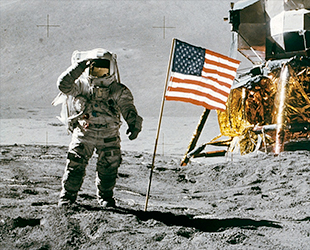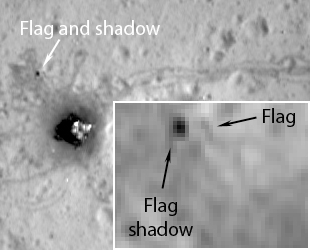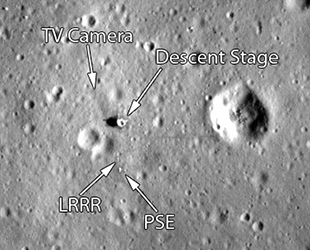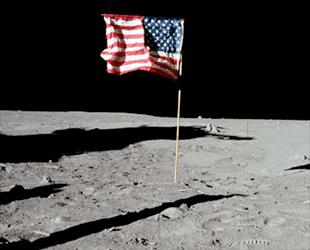July 29, 2012 — Forty-one years ago on Monday (July 30), Apollo 15 astronauts David Scott and James Irwin planted an American flag on the moon. It was the fourth star-spangled banner to be deployed on the lunar surface, out of the six that would ultimately be raised by each of the United States' manned missions to land on the moon between 1969 and 1972.
"I'll hit it a few times so it'll stay up here for a few million years," Irwin said to Scott, as he used a hammer to drive the flag's pole into the ground on July 30, 1971.
Well shy of Irwin's estimate, it took less than four decades for doubts to begin that the Apollo 15 flag — along with the five others that preceded and followed it to the moon — was still standing.

Apollo 15 lunar module pilot James Irwin salutes the flag after he and David Scott erected it to stand "a few million years." (NASA) |
Now, a NASA probe orbiting high above Hadley Rille has gave proof that the flag is still there.
By the Sun's yellow glare
Since its arrival at the moon two years ago, NASA's Lunar Reconnaissance Orbiter (LRO) has taken detailed photos of the lunar surface, including the very first views of the equipment that was left behind at the Apollo landing sites since the astronauts left the moon to come back to Earth 40 years ago.
The spacecraft's images are of high enough resolution that in addition to the moon landers, lunar rovers and surface deployed experiment packages, the astronauts' boot print tracks are also visible. But the flags are not thick enough to be resolved directly when viewed from above.
And that assumes they still exist.
"It is not really clear whether the flags are even there any more because they were not anything special, they were made out of nylon," Mark Robinson, principal investigator for the LRO Camera (LROC), said in September 2011. "In the extreme heat and [ultraviolet] UV environment on the moon, personally I would be surprised if there is anything left on them."

The flag was captured in this image of the Apollo 16 site with the spacecraft slewed 15° towards the Sun; the shadowed side of the flag is seen by LROC. (NASA/GSFC/Arizona State University) |
But as Robinson's camera circled the moon, it flew over the Apollo landing sites at different times of the lunar day. The sun's angle changed, and with it the shadows cast by the Apollo artifacts.
"The most convincing way to see that the flags are still there, is to view a time series of LROC images taken at different times of day, and watch the shadow circle the flag," Robinson wrote in a blog entry on the LROC website this week. "From the LROC images it is now certain that the American flags are still standing and casting shadows at all of the sites."
Fallen first flag
All that is, except one — the first flag on the moon.
The LROC images of the moon's Tranquility Base, where Neil Armstrong and Buzz Aldrin made history as the first men to walk on another celestial body, reveal no shadow being cast where the flag once stood.

The Apollo 11 landing site, Tranquility Base, as imaged by LROC reveals no shadows cast by the U.S. flag. (NASA/GSFC/ASU) |
But that is less a mystery than it is a verification of what Aldrin saw as he and Armstrong blasted off the moon.
"I was concentrating intently on the computers, and Neil was studying the attitude indicator, but I looked up long enough to see the flag fall over," Aldrin recounted in his 1973 memoir, "Return to Earth."
"Buzz Aldrin reported that the flag was blown over by the exhaust from the ascent engine during liftoff of Apollo 11, and it looks like he was correct!" Robinson wrote on the LROC website.
Space vs. the stars and stripes
While the LRO images confirm that the American flags at the other five landing sites are still standing, they may still be unrecognizable as "Old Glory."

The iconic red, white and blue of the American flag may be only white today due to intense exposure to UV radiation. (NASA) |
The shadows verify the physical cloth still exists, but the flags' red and blue colors may be no more.
"I was a bit surprised that the flags survived the harsh ultraviolet light and temperatures of the lunar surface, but they did," Robinson wrote. "What they look like is another question."
The same radiation that Robinson believed might degrade the flags, may have still stripped them of their colors, Paul Spudis, senior staff scientist at the Lunar and Planetary Institute in Houston, wrote in a blog entry for Smithsonian Air&Space magazine in July 2011.
"Even on Earth, the colors of a cloth flag flown in bright sunlight for many years will eventually fade and need to be replaced," Spudis explained. "So it is likely that these symbols of American achievement have been rendered blank, bleached white by the UV radiation of unfiltered sunlight on the lunar surface."
On the LROC website users can flip through the images of each Apollo landing site as taken throughout the day.
